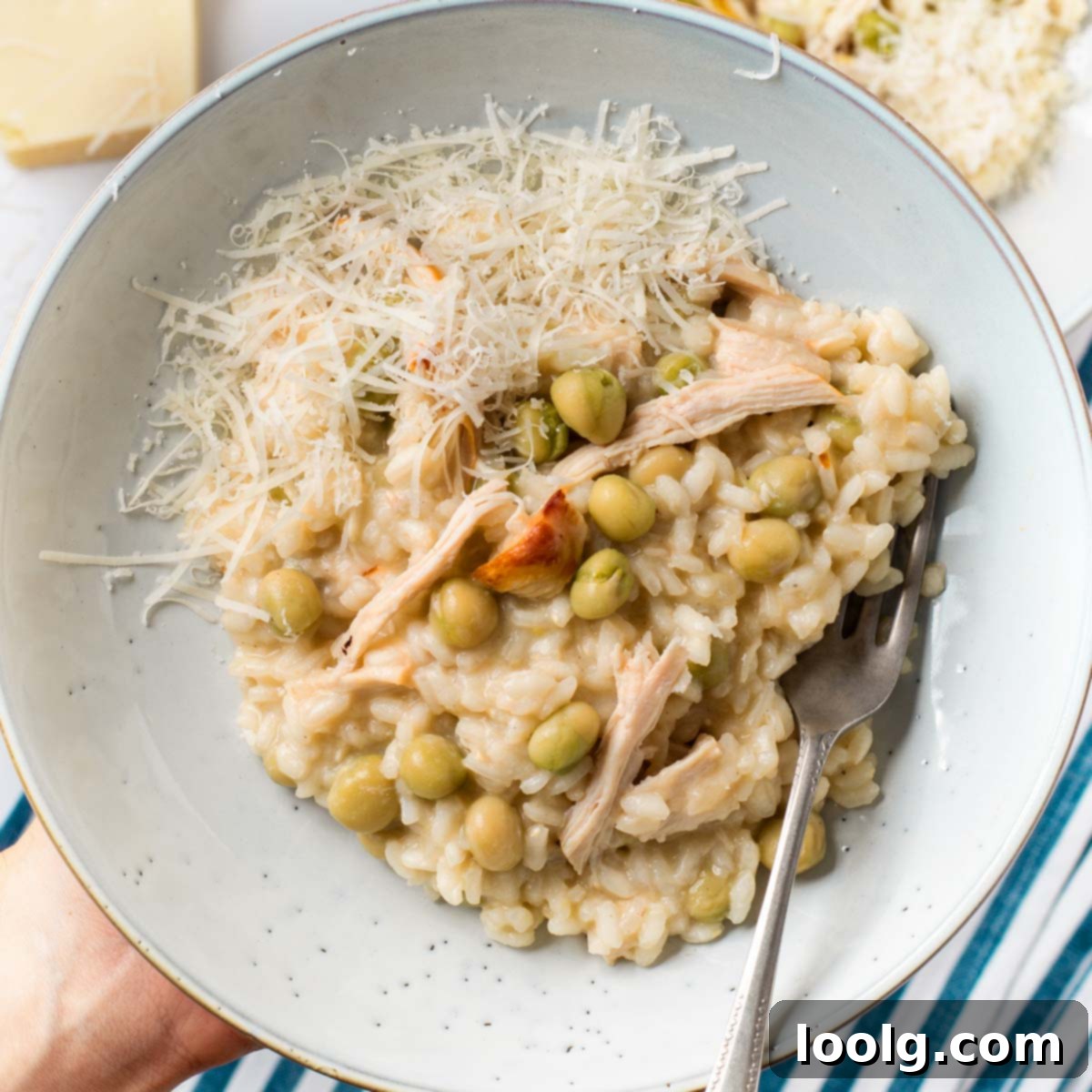Creamy Chicken and Pea Risotto: An Easy, Healthy, and Gluten-Free One-Pot Meal
Indulge in this deliciously creamy chicken and pea risotto, a perfect one-pot meal that effortlessly transitions from a comforting weeknight dinner to an elegant side dish for any occasion. It’s a wholesome, rich, and deeply satisfying dish that comes together in just about 35 minutes, and it’s naturally gluten-free!
Risotto often carries the reputation of being a sophisticated dish, typically found gracing the menus of upscale restaurants. However, creating a perfectly amazing, restaurant-quality risotto at home is far simpler than you might imagine. This recipe will transform your everyday meals into something truly delectable and memorable.
At its heart, risotto is a hearty and deeply flavorful dish that requires just a little attentive care to achieve that iconic creamy texture and perfectly cooked rice. When topped with freshly grated Parmesan cheese and combined with tender rotisserie chicken and sweet peas, the flavors meld into a sensational, velvety dish that’s hard to resist.
I have a particular fondness for one-dish meals, like this Baked Ziti with sour cream, which is zesty, incredibly filling, and super easy to prepare. Knowing I can whip up a satisfying and complete meal in a single pot or pan is a lifesaaver on busy days. This chicken and pea risotto is another fantastic addition to that repertoire, offering a convenient yet gourmet option for dinner when time is short.
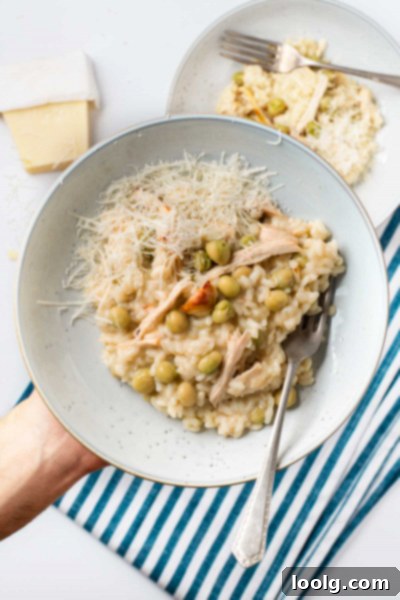
Essential Ingredients for the Perfect Risotto
Crafting this delightful chicken and pea risotto relies on a few key ingredients. Each plays a vital role in building the layers of flavor and achieving that signature creamy consistency:
- Butter: Essential for sautéing and adding richness to the final dish.
- Yellow Onion: Provides a sweet aromatic base when finely diced and caramelized.
- Garlic Cloves: Infuses the risotto with a fragrant, pungent depth.
- Arborio Risotto Rice: The star of the show! Its high starch content is crucial for achieving risotto’s characteristic creaminess.
- White Wine: Adds acidity and a complex layer of flavor; it also helps deglaze the pan.
- Unsalted Vegetable Stock: The primary liquid that cooks the rice and releases its starches. Using unsalted stock allows you to control the seasoning precisely.
- Rotisserie-Cooked Chicken: A convenient way to add tender, flavorful protein. Cut into small, bite-sized pieces.
- Frozen Peas: Adds a pop of color, sweetness, and a lovely texture contrast.
- Grana Padano or Parmesan Cheese: Essential for that salty, umami-rich finish and extra creaminess.
- Cold Butter: Stirred in at the very end to create a luscious, glossy texture, known as “mantecatura.”
- Freshly Ground Black Pepper: For seasoning and a touch of warmth.
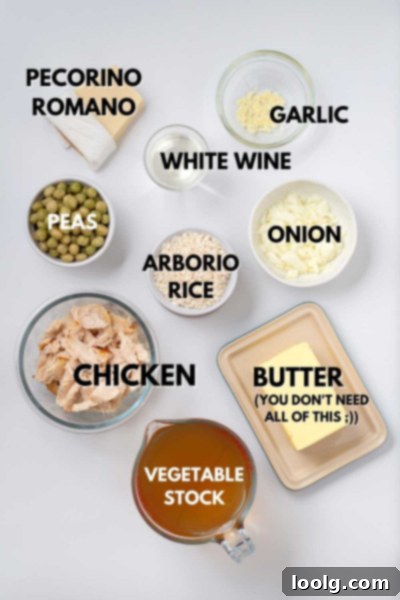
Crafting Your Creamy Risotto: A Step-by-Step Guide
The magic of risotto lies in its method. While it may seem intricate, it’s truly a straightforward process that rewards patience and attention. For the precise measurements and full recipe details, please scroll down to the comprehensive recipe box located at the bottom of this page.
- Prepare the Stock: Begin by heating your stock in a separate pot. Bring it to a gentle boil, then reduce the heat to a steady simmer. Keeping the stock hot is crucial for even cooking and preventing temperature shock to the rice.
- Sauté Aromatics: In a large, heavy-bottomed sauté pan, melt a tablespoon of butter (or use olive oil). Add the finely diced yellow onions and cook them over medium heat until they become translucent and tender, usually about 2-3 minutes. This process sweetens the onions and forms the flavor base. Then, add the minced garlic and cook for another minute until fragrant, being careful not to burn it.
- Toast the Rice: Stir in the Arborio rice. Lightly toast the grains for about 1 minute, stirring frequently. This step is vital as it “seals” the rice, allowing it to absorb liquid without becoming mushy and adding a subtle nutty flavor.
- Deglaze with Wine: Pour in the white wine. Stir continuously as the wine is absorbed and evaporates. This step deglazes the pan, picking up any flavorful bits, and adds a bright acidity that balances the richness of the dish.
- Gradually Add Stock: Begin ladling in the hot stock, adding just enough to cover the rice. Stir gently but consistently until the liquid is almost fully absorbed. This constant, gentle agitation helps release the starches from the Arborio rice, creating the creamy texture.
- Repeat the Process: Once the liquid is mostly absorbed, add another ladle of stock to cover the rice. Continue to stir and allow it to absorb. Repeat this process, ladle by ladle, until the stock is incorporated and the rice is no longer absorbing liquid, but is cooked ‘al dente’ – firm to the bite with a slight chewiness. Remember to reserve about 1/2 cup of stock for the final steps.
- Incorporate Chicken and Peas: When the rice reaches the desired al dente texture, stir in the pre-cooked rotisserie chicken pieces and the frozen peas. Add the remaining 1/2 cup of stock, or a bit more if needed, and stir to incorporate and heat the chicken and peas through. (If you happen to have any leftover peas, this Pea and Mint Soup is a fantastic way to use them!)
- Final Touches (Mantecatura): Remove the pan from the heat. Add the cold butter and a generous amount of grated Parmesan (or Grana Padano) cheese. Gently stir to melt the butter and cheese, which creates the final, rich, and glossy consistency.
- Rest and Serve: Loosely cover the risotto and let it rest for 2-5 minutes. This allows the flavors to meld and the risotto to settle to its perfect consistency. Give it a final stir, season with freshly ground black pepper to taste, and serve immediately.
While risotto can initially seem a little intimidating, mastering a few key techniques makes it much easier and more enjoyable. I highly recommend reading the following tips to ensure you achieve the absolute best risotto possible.
Expert Tips for Unforgettable Risotto
Creating a truly exceptional risotto goes beyond just following the steps; it involves understanding a few fundamental principles. These tips will guide you to a perfect, creamy, and flavorful dish every time:
- The Art of Gentle Stirring: The number one secret to great risotto is consistent, gentle stirring, roughly every minute or so. This isn’t about constant vigorous stirring, which can cool the rice too much, but rather a rhythmic motion that coaxes the starches out of the rice grains. These released starches are what create that undeniably rich, luscious, and creamy texture that defines risotto. Without sufficient stirring, the starches won’t release, and your risotto will lack its characteristic creaminess.
- Toast the Rice Properly: Don’t skip the toasting step! After sautéing your onions, add the Arborio rice and stir it around in the pan for about 1 minute until the edges of the grains become translucent, but not brown. Toasting the rice causes a slight caramelization of the starches on the exterior of each grain, which creates a protective “seal.” This seal allows the rice to absorb liquid gradually without becoming mushy, while also adding a subtle depth of flavor to the finished dish.
- Embrace the Wine’s Role: The white wine should always be added immediately after the rice has been toasted. Pour it in and let it cook down, stirring constantly, until it has almost completely evaporated. The wine’s acidity brightens the dish, cuts through the richness, and adds a layer of complex flavor that truly elevates the risotto. If you prefer not to use wine, a splash of lemon juice at the end can offer a similar acidic balance, though the flavor profile will be slightly different.
- The Power of Hot Stock: Always use hot stock! Bring your vegetable or chicken stock to a boil in a separate pot, then reduce it to a gentle simmer. Keep this pot on the stove right next to your risotto pan as you work. Using hot stock ensures that the cooking process remains continuous and even. Adding cold stock would drop the temperature of the rice mixture, shocking the grains and slowing down the cooking, potentially leading to unevenly cooked or gummy risotto.
- Ladle by Ladle, Not All at Once: Resist the urge to pour all the stock in at once. The “one ladle at a time” method is critical. Add just enough stock to barely cover the rice, stir until it’s nearly absorbed, then repeat. This gradual absorption allows the rice to cook slowly and evenly, continuously releasing its starches and preventing it from becoming a “mushy mess.”
- Maintain Even Coverage: Pay attention to your ladle size and the amount of stock you add. Each time, ensure you add just enough hot stock to cover all the rice in the pan. If some grains are left exposed, they won’t cook evenly, leading to inconsistent texture in your final risotto.
- Achieving “Al Dente”: “Al dente” translates to “to the tooth” and describes the perfect texture for risotto rice. It means the rice should be soft and cooked through on the outside, but still possess a slight, pleasant resistance or chewiness in the very center – not crunchy, but definitely not mushy. This texture is a hallmark of a well-made risotto.
- The Importance of Resting (Mantecatura): Once the risotto reaches al dente, add the cold butter, chicken, and peas, and gently heat them through. Then, remove the pan from the heat. Loosely cover the risotto for 2 to 5 minutes. This resting period, often combined with the final stir-in of butter and cheese (mantecatura), allows the mixture to settle, for the flavors to fully meld, and for the risotto to reach its ideal, flowing consistency without thickening excessively due to evaporation, or being too hot to eat.
- Perfect Consistency is Key: The ideal consistency for a finished risotto is often described as a “wave” – it should be loose and flowing, not stiff or glumpy like mashed potatoes, nor watery like soup. When you stir it, it should settle back into a level surface smoothly. If it appears too dry, you can always stir in a little more hot stock. If it’s too wet, continue to cook it for a minute or two longer, stirring until it reaches the desired consistency.
- No Heavy Cream Needed: You absolutely do not need to use heavy cream in this dish. The magnificent, rich, and creamy texture of authentic risotto comes entirely from the starches released by the Arborio rice during the cooking and stirring process. A final dab of cold butter and, of course, the grated Parmesan cheese, provide all the additional richness and velvety mouthfeel you could desire.
How Much Risotto Rice Per Person?
A good general rule of thumb for risotto rice is to use approximately 60 grams (about 2 ounces) of Arborio rice per person. This amount works well if the risotto is served as a starter, a lighter meal, or when you are bulking out the dish with other substantial ingredients like chicken and peas, as in this recipe. If you feel this might not be enough, especially if it’s the sole main course, you can increase it to 75 grams (about 2.6 ounces) per person. Just remember that if you increase the rice, you will also need to adjust the amount of stock accordingly to ensure proper cooking and creaminess.
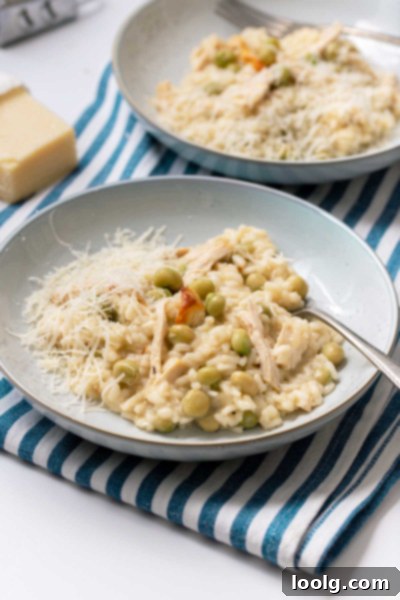
Do I Have to Use Arborio Rice? Understanding Risotto Grains
When it comes to risotto, the type of rice you choose is absolutely crucial because it dictates the final texture and creaminess of your dish. Not just any rice will do; you need a variety with sufficient starch content to achieve that distinctive luscious sauce. Italian rice varieties are specifically cultivated for this purpose.
Italy is renowned for producing three primary types of rice ideal for risotto, each differing slightly in size, starch content, and the texture they impart:
- Arborio: This is the most widely available and popular short-grain rice for making risotto, and it’s what we use in this recipe. Arborio grains are plump and absorb a large amount of liquid, resulting in a wonderfully creamy yet slightly heavier texture. Its forgiving nature makes it an excellent choice for beginners and consistently delivers fantastic results for dishes like this chicken and pea risotto (or even this delicious Vegetable Risotto!). While Arborio is a safe bet, feel free to experiment with other types to discover the texture and taste you prefer most.
- Carnaroli: Often referred to as the “king of risotto rice,” Carnaroli is a plumper and larger grain than Arborio, boasting an even higher starch content. It produces an ultra-creamy texture while maintaining a lovely al dente bite. Carnaroli is highly regarded for its ability to hold its shape exceptionally well throughout the cooking process, making it a favorite among professional chefs.
- Vialone Nano: This type of rice is stubbier and thicker compared to Arborio and Carnaroli. It excels at absorbing liquids effectively, making it particularly well-suited for more soupy or “wetter” risottos, which are frequently served with delicate seafood preparations.
While these Italian varieties are traditional, if you’re feeling adventurous or looking for an alternative, you can explore recipes like this Butternut Squash Risotto, which ingeniously uses brown rice for a different take on the classic!
Choosing the Right Stock: Vegetable vs. Chicken
The stock you use is as important as the rice itself, as it provides the liquid medium that cooks the rice and extracts its essential starches, forming the creamy base of your risotto. It also profoundly influences the overall flavor profile of the dish.
You have a choice between using vegetable stock or chicken stock (or broth). Each brings its own characteristics:
- Chicken Stock/Broth: Using chicken broth will impart a much heartier, deeper chicken flavor to your risotto. This can be wonderful if you want the chicken taste to be more prominent. (You can even use leftovers from making your own chicken stock in a delicious Gluten-Free Cream of Mushroom Soup!)
- Vegetable Stock: Vegetable stock is an excellent choice, particularly for this chicken and pea risotto, as it offers a clean, savory base that won’t overpower the natural goodness of the added chicken and sweet peas. It contributes a great taste and essential nutrients without competing with the main ingredients.
For this specific recipe, I personally prefer vegetable stock. I find that the naturally delicious taste of the added rotisserie chicken shines through beautifully, complemented by the vegetable stock rather than being overshadowed by a strong chicken-flavored broth. This allows for a more balanced and nuanced dish.
Remember, making risotto is not just about mixing rice with other ingredients; it’s a symphony of flavors and techniques that, when executed correctly, yields a dish as delightful as a meticulously crafted gourmet meal. The stock is key to this, as its warmth ensures continuous, even cooking, which is crucial for perfect starch release.
Ideally, your stock should be flavorful, aromatic, and unsalted. Using unsalted stock allows you complete control over the final seasoning of your risotto. A stock that is too concentrated or overly salty can easily overpower the delicate balance of the risotto, so it’s best to keep it light, bright, and allow the other ingredients to shine.
If you’re truly dedicated to making the best risotto possible and want to go the extra mile, consider making your own homemade vegetable stock. It takes about an hour and ten minutes to prepare but can easily be made ahead of time and stored, providing a superior flavor base that elevates any dish.
No Rotisserie Chicken? No Problem!
While rotisserie chicken offers incredible convenience and flavor, it’s absolutely fine if you don’t have any on hand. You can easily prepare chicken breasts (or thighs) to use in your risotto. Simply season your chicken pieces generously with salt and pepper, then add them to a pan with a little olive oil. Gently fry or sauté them until they are thoroughly cooked through and golden brown. Once cooked, let them rest briefly before cutting them into small, bite-sized pieces suitable for adding to your risotto.
And if you happen to cook extra chicken, consider making this fantastic balsamic rosemary chicken for another meal!
Do You Have to Use Parmesan Cheese? Exploring Alternatives
Traditionally, Parmesan cheese (Parmigiano-Reggiano) has been the undisputed king of cheeses for risotto, gracing Italian tables for centuries. My Italian friends would likely assert that there is no other cheese to be used, given the rich history and tradition woven into Italian culinary practices.
However, while tradition is cherished, there are indeed other excellent cheese options that can bring equally amazing taste profiles to your chicken and pea risotto. These alternatives can create a slightly different, but equally delicious, experience:
- Grana Padano: A fantastic substitute for Parmesan. Grana Padano offers a similar savory, nutty flavor but is often a bit milder and can create an even cheesier, creamier sauce than traditional Parmesan, due to its slightly higher fat content and different aging process.
- Pecorino Romano: If you enjoy a sharper, more piquant flavor, Pecorino Romano is a wonderful choice. Made from sheep’s milk, it has a saltier and more robust profile that can add a delightful zing to your risotto.
Ultimately, any hard, aged Italian-style cheese would be a good fit for this dish, contributing to its creamy texture and rich flavor. If you’re keen to explore more about various cheese types suitable for risotto, The Kitchn has an informative article you can read here. Though, as mentioned (and with a playful wink to tradition 😉), you won’t find an Italian using sharp cheddar cheese for risotto, despite it being listed as an option for those who choose to “not get caught up in the rules.” Stick to Italian-style hard cheeses for the best results!
Is Risotto a Healthy Dish? Debunking the Indulgence Myth
Risotto, with its famously creamy and luxurious texture, often gives the impression of being an indulgent and potentially unhealthy dish. However, this is a common misconception! In reality, risotto, particularly when made with Arborio rice and wholesome ingredients, can be quite healthy and nutritious.
Here’s why risotto is a healthier choice than it might appear:
- Fiber-Rich Arborio Rice: Arborio rice, the foundation of our risotto, is actually packed with more dietary fiber than many common pasta varieties. Fiber is essential for digestive health, helps regulate blood sugar levels, and contributes to a feeling of fullness, which can aid in weight management.
- Naturally Creamy, No Heavy Cream Needed: As discussed earlier, the creamy texture of authentic risotto comes from the natural starches released by the rice, not from copious amounts of heavy cream. This significantly reduces the fat and calorie content compared to dishes that rely on cream-based sauces for richness. The small amount of butter and cheese added at the end provides flavor and sheen, not the bulk of the creaminess.
- Nutrient Powerhouse: Arborio rice itself is a good source of carbohydrates for energy, along with a decent amount of protein, essential vitamins, and minerals. A single serving can provide around 9 grams of protein, making it excellent for muscle building and repair. Furthermore, it’s often enriched with vitamins A and C, contributing approximately 12% of your daily recommended intake for these crucial vitamins, and about 45% of your daily requirement for essential nutrients.
- Easy to Digest: The way risotto rice breaks down during cooking makes it relatively easy to digest, providing sustained energy without feeling overly heavy.
So, when compared to many other starchy alternatives, a well-prepared risotto like this chicken and pea version is a wholesome, balanced, and delicious meal that the entire family can enjoy without guilt, supporting your fitness goals while delighting your taste buds.
Do You Have to Stir Risotto Constantly? Finding the Right Balance
No, you absolutely do not need to stir risotto constantly! In fact, constant, vigorous stirring can be detrimental to the final texture of your risotto. Over-stirring introduces too much air into the mixture, which can cool it down prematurely and prevent the rice from cooking evenly. This often results in a gluey, rather than creamy, consistency – which is definitely not what we want for this amazing dish!
The key to perfect risotto is finding a nice balance in your stirring technique. You need to agitate the rice enough to encourage the release of starches that create creaminess, but also allow it moments of rest to absorb the stock properly. If you don’t stir it enough, the rice grains at the bottom can stick to the pan and burn, or cook unevenly.
The ideal approach is to stir often, but gently, allowing short breaks in between. After adding a ladle of hot stock, give it a good stir, then let it simmer gently for a minute or so, absorbing the liquid. Stir again when you see the liquid diminishing and the rice starting to peek through. Repeat this process until most of the stock is absorbed and you have perfectly al dente risotto. It’s about rhythmic attention, not relentless agitation.
Achieving the Perfect Risotto Texture: The “Wave”
The texture of risotto is paramount to its overall appeal and is a hallmark of a properly executed dish. You are aiming for a specific, desirable consistency – not gloppy, not gooey, and certainly not wet and soupy, yet not firm and dry.
A good risotto should have what Italians call an “all’onda” consistency, meaning “like a wave.” When you scoop it with a spoon and then gently shake the pan, the risotto should flow and spread slowly like a soft wave, settling back into itself. It should have body and substance, but absolutely not be mushy or pasty. If you can mold the risotto into a solid shape, it has been overcooked and is too thick.
It should be dense and satisfying, yet still fluid. Achieving this delicate balance between firmness and fluidity is the ultimate reward of a well-made risotto. If your risotto appears too dry, simply stir in a little more hot stock, a tablespoon at a time, until it loosens to the desired consistency. Conversely, if it’s too wet, continue to cook and stir for a few more minutes to allow more liquid to evaporate and starches to develop.
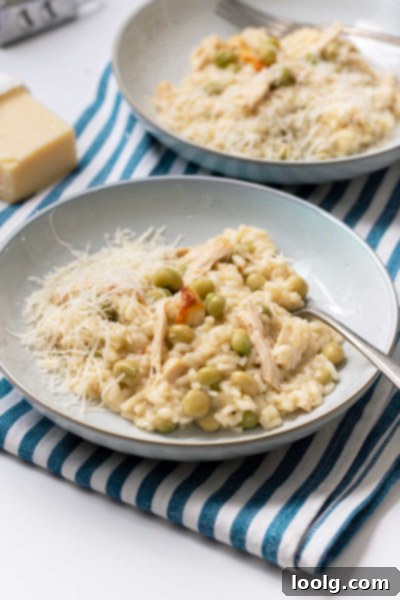
Do I Need to Wash Risotto Rice?
No, definitely not! Unlike many other rice varieties where rinsing is recommended to remove excess starch, you explicitly do *not* want to wash risotto rice. The starches on the exterior of Arborio (or Carnaroli/Vialone Nano) rice grains are precisely what create the signature creamy, luscious texture of the dish. Rinsing them off would strip away this essential component, resulting in a less creamy and satisfying risotto. So, keep those starches where they belong!
Do You Cook Risotto With the Lid On or Off?
For the majority of the cooking process, risotto is prepared with the lid off. This is crucial for several reasons: it allows for constant stirring (which is key to starch release), it facilitates the gradual evaporation of the stock, and it lets you monitor the rice’s absorption and texture. Cooking with the lid on would trap steam, potentially making the rice cook too quickly or become mushy, and wouldn’t allow for the necessary stirring technique.
The only exception to this “lid off” rule is at the very end. Once the risotto is cooked to al dente, you remove it from the heat, add the butter and cheese, give it a final stir, and then loosely cover the pan for 2 to 5 minutes. This brief resting period is an important step known as “mantecatura” (though it also applies to the resting part), allowing the flavors to meld, the butter and cheese to fully integrate, and the risotto to settle into its perfect creamy texture without evaporating further or becoming too hot to eat immediately.
Do You Have to Use Wine in Risotto? Alternatives for Acidity
Wine is indeed considered a signature ingredient in traditional risotto dishes. Its inclusion serves a couple of important purposes: it adds a subtle hint of complex flavor, and critically, it provides a crucial acidic balance to the richness of the dish. This acidity brightens the overall profile and prevents the risotto from feeling too heavy or one-dimensional.
However, if you forgot to buy wine, prefer not to use alcohol, or simply don’t have any on hand, don’t let that stop you from making this delicious risotto! You can absolutely leave the white wine out. To compensate for the acidity that the wine would typically provide, simply squeeze in a bit of fresh lemon juice towards the end of the cooking process, perhaps when you add the chicken and peas, or during the final “mantecatura” step. Start with a teaspoon and add more to taste until you achieve that desired bright balance.
Can I Freeze Risotto? Storage and Reheating Tips
Yes, you can freeze risotto, making it a convenient option for meal prep or for entertaining guests without last-minute stress. While freshly made risotto is always ideal due to its delicate texture, frozen and reheated risotto can still be very satisfying with the right technique.
Here’s how to freeze and reheat your chicken and pea risotto:
- Cool Completely: After cooking, allow the risotto to cool completely to room temperature. This is important to prevent ice crystals from forming and affecting the texture.
- Portion and Freeze: Once cooled, transfer the risotto into airtight freezer-safe containers or heavy-duty freezer bags. If you’re planning individual portions, divide it before freezing. It can be stored in the freezer for up to 3 months.
- Thaw: When you’re ready to enjoy it, thaw the frozen risotto in the refrigerator overnight.
- Reheat in the Oven: For best results, reheat the thawed risotto in the oven. Transfer it to an oven-safe dish with a lid. Heat it at 355°F (180°C) for approximately 20 to 30 minutes, or until it’s piping hot all the way through.
- Add Fresh Ingredients: During the reheating process (or just before serving), you might want to add a splash of extra hot stock or water to restore its creamy consistency, as it tends to thicken in the fridge/freezer. Once hot, stir in the cooked chicken and peas (if not already incorporated or if adding fresh ones), and finish with more grated cheese and a pat of butter for freshness and flavor before serving.
While reheating won’t perfectly replicate the delicate texture of freshly made risotto, this method will yield a delicious and comforting meal ready in a pinch.
Other Fantastic One-Pot Recipes to Try
If you love the ease and convenience of one-pot meals, here are some other incredible recipes to add to your rotation:
- Quinoa Pizza Casserole
- Spaghetti Squash Alfredo
- 1 Pot Pasta with Cherry Tomatoes
- Hamburger Helper from Scratch
- Instant Pot Tortellini Soup
- Gnocchi with Lighter Tomato Cream Sauce
What is your favorite one-pot meal? Share your go-to dishes in the comments below!
If you try this delightful Chicken and Pea Risotto, please let me know how it turned out for you! I’d love to see your creations. Snap a pic and tag #FoodDoodlesRecipes on social media so I can be sure to admire your fantastic culinary efforts!
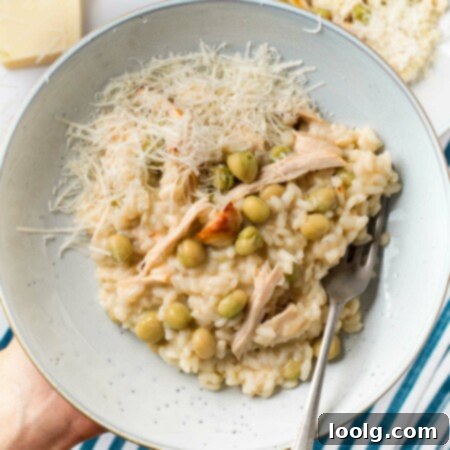
Chicken and Pea Risotto
Ingredients
- 1 tablespoon (14 grams) unsalted butter
- 1 yellow onion finely diced
- 2 large garlic cloves minced
- 9 ounces (255 grams) arborio risotto rice
- ½ cup (120ml) white wine
- 5 cups (1.2l) vegetable stock
- 9 ounces (255 grams) rotisserie-cooked chicken cut into small pieces
- 7 ounces (200 grams) frozen peas
- ⅓ cup Parmesan, Pecorino Romano or another hard Italian-style cheese, finely grated
- 2 tablespoons cold butter
- freshly ground black pepper
Instructions
-
Add the stock to a medium pan over low heat and gently simmer.
-
Bring a large saute pan at medium heat, once hot, add the olive oil, onion and cook for 2-3 minutes. Add the garlic, stir and add the arborio rice. Cook, stirring frequently for 1 minute.
-
Pour the white wine and stir, allowing the alcohol to evaporates, about 1 minute.
-
Pour 1 cup of the stock and stir well with a wooden spoon. Simmer on medium-low heat, uncovered for 5-6 minutes until all liquids were absorbed by the rice.
-
Place the pan with stock on the stove next to the risotto saute pan with a ladle.
-
Continue to cook the rice by adding a ladle of stock each time the risotto dries out. Stir frequently with a wooden spoon and repeat this process until most of the stock is incorporated into the risotto, about 20 minutes until the rice is al dente. Save about 1/2 cup of the stock.
-
Check the consistency of the risotto, the rice should be soft on the outside and gently crunchy in the middle. At this point, add the chicken, peas and another ladle of stock, give a gentle stir to incorporate the new ingredients. Continue to cook to heat the peas and chicken. Remove from the heat.
-
Add the cold butter and stir gently but frequently to melt and finish with the grated cheese.
-
Season with black pepper and serve immediately.
